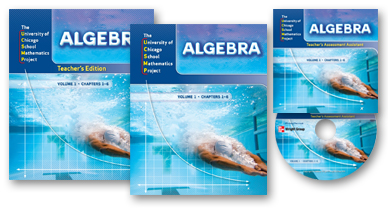[Note: I orignally reviewed the second edition of this course, but the third edition is now available. I do not expect that there are significant changes in the new edition.]
The University of Chicago School Mathematics Project (UCSMP) math program has produced six texts teaching integrated mathematics for junior and senior high levels. The first book in the series, a pre-algebra text, is titled Transition Mathematics. This Algebra text is second in the series. This is probably the best and most comprehensive of the new math programs based on the new math standards. It stresses four "dimensions of understanding": skills, properties and relationships, applications, and representation of mathematical concepts. Rather than teach concepts in a theoretical manner, it presents concepts in contexts, using illustrations or other means of showing how they might be used.
Each lesson presents a concept within the textbook, including explanations that students can understand without a teacher's presentation. Sample problems are shown. A set of questions concentrates on the new concept then another set of problems reviews previously learned concepts. The final group of problems is for "exploration." Occasionally, these questions will require outside research in a dictionary, encyclopedia, or other reference works. There are also optional projects that can be pursued selectively, depending on time and the needs of each student.
The organization is quite different from traditional texts. Since mathematical thinking is a major goal, some concepts that are saved for higher levels in traditional programs are integrated in early Algebra lessons. In keeping with the new math standards, students must use a scientific calculator with the text, and a graphing calculator would be even better. (An appendix offers lessons in using scientific calculators.) Other reflections of the standards are the inclusion of numerous problems which students must answer with written explanations to demonstrate both understanding and their ability to explain the concept to others, much work on interpretation of graphs and charts (questions using these skills show up with increasing frequency on standardized tests), thoroughly developed treatment of the graphing of equations and inequalities (beyond what we find in most Algebra I texts), the integration of geometry (e.g., Pythagorean Theorem, volume of solids), and the inclusion of a chapter on functions (usually reserved for higher levels).
There are self-tests and review tests following each chapter, and these might be sufficient for tracking student progress. Selected answers to exercises and reviews are found at the end of the student text. An Assessment Sourcebook contains more thorough tests, but it is probably too expensive for most home educators.
You really do need the teacher edition, which is far more than an answer key. (Unfortunately, the website does not provide ordering information on the teacher edition.) Some lesson preparation is necessary, although students can do much of each lesson independently. Parents with weak math backgrounds should go through the text with their teens so that they are able to be involved when necessary.
At almost 900 pages, there seems to be more here than the average student can complete in a single school year, although the teacher's guide indicates that average students should be able to complete 12 of the 13 chapters. The teacher's guide suggests that you use the text at whatever grade level is appropriate for each student, anywhere from seventh grade through tenth grade according to their charts showing suggested sequences for using their series of math texts. Even though this text is classroom-designed and suggests some group activities, it should work well for home educators. You can follow with the next UCSMP texts, Geometry; Advanced Algebra; Functions, Statistics, and Trigonometry; and Precalculus and Discrete Mathematics.








